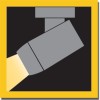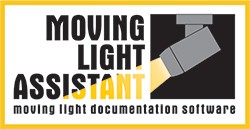It is now possible to use a video camera (such as a web cam) or video input card to capture still images in the Preset Documentation and Cue List views as you would with a tethered DSLR camera. Video cameras/input cards supported by AV Foundation on Mac OSX and Direct Show on Windows OS should be compatible.
To use a video device, it works pretty much as you would to use a tethered DSLR camera.
- Open the ‘Camera Setup’ dialog from the
Setupmenu by clicking on Camera… - From the ‘Camera Control’ drop-down menu, choose either ‘AV Foundation’ on Mac OSX, or ‘Direct Show’ on Windows OS.
- The device list will populate with the available cameras or devices.
- Select the device you wish to use, and click the Connect button.
Taking photos works as it would with a DSLR camera in the Preset Documentation and Cue List views.
When the ‘Video Aspect Ratio’ pop-up menu is enabled, it allows you to choose the aspect ratio of the input video. The choices are ‘Native’, ‘HD (16:9)’ and ‘SD (4:3)’. It is only possible to choose the aspect ratio when you are not connected to a video input device. The ‘Native’ aspect ratio will not always be the actual aspect ratio of the input device, so it is worth looking at the preview to decide if it looks correct.
If the ‘Live Preview’ checkbox is checked, then a live video preview window will open and float on top of the main document window. ‘Live Preview’ is greyed out when using AV Foundation. In the bottom left of the ‘Live Preview’ window, there is a ‘Settings’ button that allows some control over the image.
When using a video input card (such as the DeckLink Mini Recorder) the video format must be set to match the incoming video signal for the video to be displayed. You can try different formats until an image is displayed. In the ‘Settings’ dialog (click on the Settings button in the ‘Direct Show Live Preview’ window) there is a ‘Video Format’ pop-up menu to chose the input device’s video format.
Camera Control – AV Foundation (macOS Only)
Some Black Magic Design video capture interfaces will work with Moving Light Assistant. Successful tests were using macOS 13.1(ARM) and 12.6 (Intel) with the BlackMagic Desktop Video drivers 12.4.2 installed. The interface was the BlackMagic Design UltraStudio Mini Recorder 3G. In Moving Light Assistant use the AV Foundation connection. You may need to hit the Refresh button for the interface to be displayed.
If your device does not appear, check that you can open the BlackMagic Desktop Video Setup application and see your device. Ensure that you have the correct video source selected. If after installing the latest drivers the setup application is not showing your device, check System Preferences -> Security & Privacy -> General Tab and ensure that the software is not blocked. If it is, click Allow.
If all you get is a black preview window, quit Moving Light Assistant and check that you can see the video input using the BlackMagic Media Express application. You may need to unplug and reconnect your device. Once you can see the video, quit the BlackMagic Media Express application and try Moving Light Assistant again.



